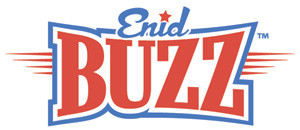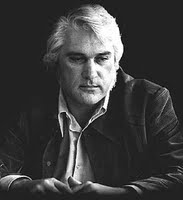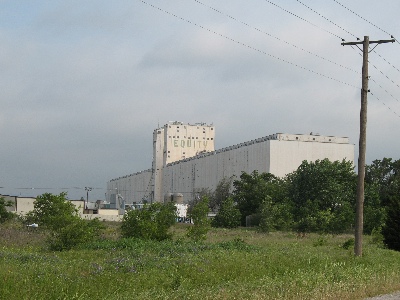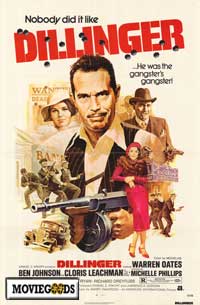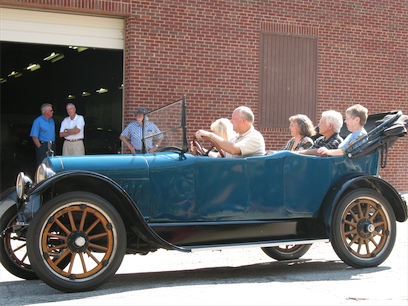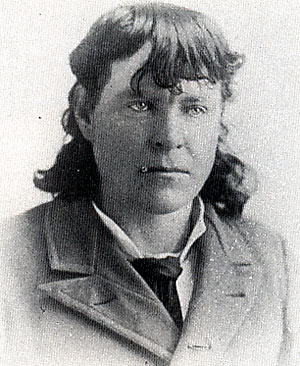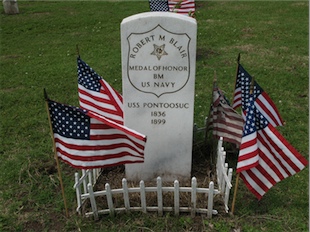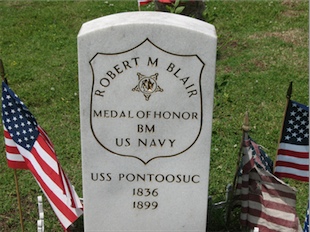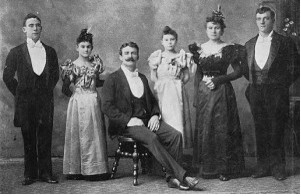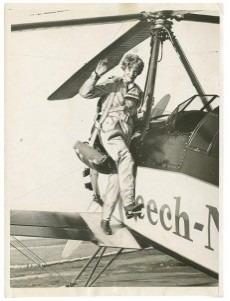This page is currently under redesign!! Check back soon!
Livestock dealer is nation's biggest (Feb 2011). Ray Winter and his son, Mark Winter brought the business to Enid in the early 1990s. Since then, it has become the largest independent cattle marketing company in the nation. The Enid-based company sells about 600,000 cattle annually. There is enough room to hold 10,000 to 12,000 cattle at the business located on US 412 between Enid and Lahoma.
Charlie Rich (December 14, 1932 - July 25, 1995)
was an American Country Music Singer/Musician. He was a Grammy Award winner that played and sang rockabilly, jazz, blues, country, and gospel. Rich actually began his professional music career while stationed at Vance, AFB in Enid! Rich spent four years (1953 - 56) in the Air Force, based in Enid, Oklahoma, where he played with a blues and jazz group called the Velvetones. He is perhaps best remembered for a pair of 1973 hits, "Behind Closed Doors" and "The Most Beautiful Girl".

Mike Cooper, military liaison for the city of Enid. “Vance is the second-busiest airport in the world.”
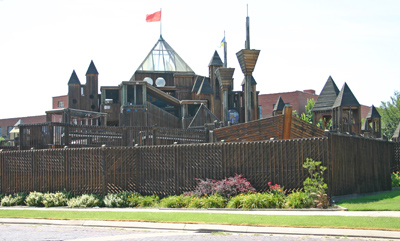
Leonardo's Discovery Warehouse & Adventure Quest were built in Enid, Oklahoma, by Owen K. and Helen Garriott. Adventure Quest, the outdoor science park is one of the largest playgrounds of its kind in the world! It took 12,000 volunteers (one-fourth of Enid’s population at the time) more than 150,000 volunteer hours before the playground opened in September, 1996.The three-story wooden castle features bridges, slides, swings, mazes, a water table, dinosaur dig, and tot lot designed to spark the imagination of the young and young at heart.Today, it remains the world’s largest community built outdoor playground and a visible reminder of what Enid can accomplish when we all work together.
Union Equity Cooperative Elevator Z, built in 1949; Union Equity Coop-erative Elevator Y, built 1953-54; Wheat Pool Terminal Elevator, 1801 N. 16th, built 1946-49; General Mills Ter-minal Elevator, 1702 N. 10th, built 1929; Union Equity Cooperative Elevator A, near North 10th between the railroad tracks and vacated portion of Hemlock, built 1931 with later additions; Southwest Terminal Elevator Fuquay and Salina Terminal Elevator, west of North 10th between the railroad tracks, built 1926-27; and Enid Terminal Elevator, 1015 N. Van Buren, 1925-26 with later additions (May 2009: The Oklahoma State Historic Preservation Office added Enid's Terminal Grain Elevators Historic District, to the National Register of Historic Places. Although grain elevators are common in Oklahoma, Enid's configuration is unique.) Enid hit its peak with a total grain storage capacity of 80,000,000 bushels in 1987. The 1980 grain embargo instated by President Jimmy Carter a poor economy, and drought lead to the closure of several of the elevators. In 1989, the Union Equity Co-Operative Exchange Elevators A and B and the Oklahoma Wheat Pool Terminal Elevator were shut down. Enid holds the title of having the largest grain storage capacity in the United States and the third largest in the world. Union Equity, Continental, Pillsbury, General Mills, and other grain companies operated mills and grain elevators in the area, creating what is now the Enid Terminal Grain Elevators Historic District, and earning Enid the titles of "Wheat Capital of Oklahoma", "Queen Wheat City of Oklahoma," and "Wheat Capital of the United States"
Did John Wilkes Booth die in Enid??
After assassinating President Abraham Lincoln, Booth was smuggled by the Confederate underground to Texas, where he began living under the name John
St. Helen. In the 1870s he worked as a bartender in a saloon in Granbury, Texas, and began telling people about his past. When the Knights of the Golden Circle found out, the decision was made to silence him. Booth fled Granbury. Jesse James, along with William "Wild Bill" Lincoln (a distant cousin of President Lincoln), tracked Booth to Enid, Oklahoma, where he had assumed the name David George. In a sworn statement, "Wild Bill" Lincoln wrote: "Our branch of the Lincoln family was never satisfied with what really happened to Booth, and I spent fourteen years of my life running down the true story. Strangely enough, I learned it from Jesse W. James, head of the Confederate underground. I was present at Booth's real death." According to Lincoln, he and James crept into Booth's room and tricked him into drinking a glass of arsenic-laced lemonade. The massive amount of arsenic consumed by Booth caused his body to mummify. James arranged for the body to be exhibited on a national carnival tour. The mummy's present whereabouts are unknown. (more info)
Stars of a Discovery Channel television show were in Enid, August 2009, searching for the ghost of John Wilkes Booth.
Brad and Barry Klinge, stars of “Ghost Lab,” along with their investigative team, Everyday Paranormal, came to Garfield Furniture to search for the presidential assassin, according to Alan Lagarde, one of the executive producers of “Ghost Lab,” which will air this fall.
“We are conducting a paranormal investigation,” Lagarde said. “This episode is related to the possible ghost of John Wilkes Booth.”
The Klinges brought their “ghost lab,” a 24-foot car hauler capable of providing 200,000 watts of electricity to Enid. It contains audio, video and photo analysis stations; flat screen televisions; an interactive touch screen smart board; surveillance video cameras capable of shooting 300 feet away in total darkness with 180 degree peripheral view; temperature/ humidity/dew point data loggers; various digital cameras, including thermal imaging cameras and audio recorders; and more than 8,000 feet of video cable. This on-site, high-tech lab enables investigators to analyze data on the premises in real-time, helping them to more narrowly focus their investigations on known paranormal hot spots. Lots more detailed info on this at: John Wilkes Booth
Remember the movie Dillinger in 1973.........
Lots of antique cars from Enid residents were used in the movie (a lot more were not as people didn't want machine gun bullet holes in their cars!) Many Enid residents landed bit parts in the movie.
Cast included:
Warren Oates .... John Dillinger
Ben Johnson .... Melvin Purvis
Michelle Phillips .... Billie Frechette
Cloris Leachman .... Anna Sage
Harry Dean Stanton .... Homer Van Mete
Quotes from Jurassic Park III: The last lines in the movie: Erik: Where do you think they're going? Dr. Grant: I don't know. Maybe just looking for new nesting grounds. It's a whole new world for them. Amanda: I dare 'em to nest in Enid, Oklahoma. According to a prop from the film, the Kirby's live at "333 Seneca Ave" in Enid, Oklahoma. Both Seneca Ave and Westgate Rd (the location of Kirby Paint & Tile Plus) are real roads in Enid. (From: Sean Archer) Where in Oklahoma is the Westgate Shopping Center located? Enid. Listen closely when everybody went back to the plane to get their stuff.
Remember the TV show "The Rifleman"?

"In the eipisode "The Guest" (season five) they named the hometown of Lucas McCain as Enid, Oklahoma. "
And another mention was: The old Dunlop place was burned and replaced with the house we came to know & love. If you remember, the rebuilt house was the same house Lucas had back in Enid, Oklahoma. As Luke said to Mark...."same house, same barn and except for the cross that bears your Mother's grave at the create of that hill, same hills".
The first woman to command a Space Shuttle mission, Commander Eileen Marie Collins. Collins graduated in 1979 from Air Force Undergraduate Pilot Training at Vance AFB, Oklahoma, where she was a T-38 instructor pilot until 1982.
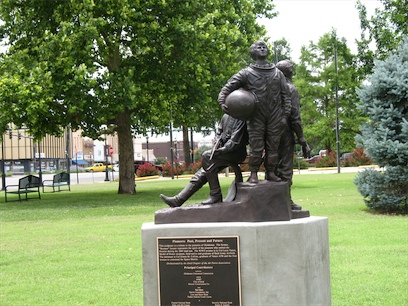
Pioneers Past, Present and Future Statue on the Court House Lawn Monument features 3 half life sized figures. A Boomer who participated in the Land Run, a WW II aviator and an astronaut (the astrounaut is of Col. Eileen Collins who went through pilot training at Vance, was an IP and became the first woman space shuttle commander.)
Okla Pilot Picked as First Female for New Aircraft. Second Lieutenant Sara Faibisoff a U.S. Marine pilot at Vance Air Force Base in Enid is the first female assigned to fly the new V-22 Osprey.
Oklahoma has produced more astronauts than any other state. These include Major General Thomas P. Stafford (Weatherford); Gordon Cooper (Shawnee);

Owen Garriott (Enid);
Shannon Lucid (Oklahoma City) and William Reid Pogue (Okemah).
The classic wooden carousel at Meadowlake Park was built in 1925 and was located in Hellum's Amusement Park, Lake Hellum's north of Enid from 1928 to 1965 when it was moved to Meadowlake Park a former Trolley Park. Carousel runs clockwise!
Dr. Henry B. McKenzie arrived in Enid September 16, 1893 and immediately took care of two persons with broken legs. He also delivered the first baby born in Enid on September 30, 1893. Her name was Enid Mae McKenzie Hungate. Dr. McKenzie had a long beard extending almost to his knees. However, he usually kept his beard neatly tucked up under his chin with hair pins. It is interesting that the first Bermuda grass lawn in Enid was started by them from a shoe box of grass brought from Texas. by Betty Jo Scott)
Team #20, 1922 Enid Harvesters (104-27) By Bill Weiss & Marshall Wright, Baseball Historians (This is the 81st article in a series of the 100 greatest Minor League Baseball teams. See "Top 100 Teams" for archived stories) In the early 1920s, a team representing a small town in a long defunct league finished with a winning record the likes of which have never been equaled. However, to accomplish this goal, the team needed help from a team that went belly-up three weeks before the end of the season. The town of Enid, located in north-central Oklahoma, joined the ranks of pro baseball in 1904. Here, a team called the Evangelists won a first half title in the Class D Southwestern League, finishing with a combined 46-37 record in their sole year in the league. Four years later, Enid joined the Class C Western Association, a league which featured teams in Oklahoma, Kansas and Missouri. In their first season, the Railroaders finished dead last with a record of 38-99. The team then enjoyed a complete turnaround in 1909, winning the pennant with an 82-44 mark. After a second place finish the following year, the team dropped out of the league. More.................
During World War II Enid Air Force Base had a baseball team called the Enid Airs.
President Grover Cleveland designated September 16, 1893, as the date of the "run." On that day, an estimated 100,000 people rushed in from the borders to stake a claim. They came by horse, train, wagon, and even on foot, all trying to claim the best farmland or town lot. Many of the hopeful settlers remained landless, shunning the rough terrain in the western part of the Outlet. By the end of the day, farms were being established, and the cities of Enid, Perry, Alva, and Woodward had risen out of what had been virgin prairie the day before.
Each year since 1935, the National Baseball Congress has gathered together the top-ranked semi-pro baseball teams in the country for a tournament to determine the best team in the nation. Backed by the rich oil-producing companies, the team from Enid, Oklahoma, took top honors at the National Baseball Congress World Series in 1937, again sending the Bona Allen team home with the second place cup.
What was the result of the Paranormal Activity Investigation of the "Ghost of the Gaslight"? The ghost was known to be in the former home of the Gaslight Theatre (Alton Mercantile Company Building), Enid, Oklahoma.
"Spirited" Stories Surrounding the Places and People of Enid's Oldest Theatres.
CESSNA AIRCRAFT COMPANY Inc. Clyde V. Cessna who was originally a motor mechanic, built his first aircraft at Enid, Oklahoma in the Spring of 1911, testing many of his early planes on the salt flats. In 1917 when bankers in Enid refused to loan him more money to build his planes, he moved to Wichita, Kansas.
Geronimo Motor Company: Founded by William C. Allen and incorporated in 1917. It made tractors, a roadster, and a five-passenger, full-size automobile. The company manufactured one thousand cars that were distributed by agencies in Kansas, Nebraska, West Texas, and Oklahoma. Geronimo ended production in 1920, when its thirty-thousand-square-foot factory burned.
Geronimo. N.d. but c. 1917. Circular board. Superlative illustration of Chief Geronimo in profile, in shield, with wreath. "...Enid, Okla." Geronimo automobile items of any description are virtually uncollectible; one of the foremost literature collectors had only one piece, torn and incomplete, in his lifelong collection. The original artwork for this logo is a remarkable item.
-------
Enid News & Eagle
Published: July 27, 2009 10:23 pm
In 1917, Enid hoped to be the second Detroit
By Robert Barron, Staff Writer
Enid was once home to a successful car manufacturer along local hopes of being the second Detroit, according to automobile historian Bud Smith.Smith, who is president of Liberty Federal Bank, told Enid Rotary Club Monday about the Geronimo, which was manufactured in Enid from 1917 until 1920. It was a successful company until the factory was destroyed by fire in 1920, which put the company out of business. William C. Allen formed the company in 1917 and initially sold $500,000 in stock, a fortune for that time. They began production of the car at 409 S. Grand and the building still has the Geronimo name on it. There also is one Geronimo remaining, and it is owned by the Enid Region of the Antique Automobile Association of America, which restored the car after it was found in a Kansas pasture. There were two models of the Geronimo built the 6A-45 and the 4A-40. The first had a six-cylinder 230 cubic inch Rutenberg engine that reportedly obtained 45 horsepower or a 55-horsepower six-cylinder engine. The second vehicle was a four-cylinder model with a Lycoming 166 cubic-inch engine that had 37 horsepower. The four-cylinder model sold for $895, and the six-cylinder model sold for $1,295. Among the other features were a high-grade motor driven horn, a complete set of tools, a motor-driven tire pump hooked up to the transmission and the hose was enclosed in a compartment behind a small door under the fender. Because of the popularity of the car, a new and larger plant was built on the “outskirts” of Enid at Cleveland and Oklahoma. The new plant was completed in the fall of 1917. The company purchased ready-made parts from specialty companies and assembled cars of their own design. At the January 1919 stockholders meeting, Allen was re-elected president and the company reported an additional $500,000 in stock sold for a total of $1 million. Employment varied from 40 to about 125 during the peak times of the company. The plan turned out one car a day. They also manufactured cars for France under the name “Wing.” By 1919 the price had also increased to $1,955 for one model. During the production, more than 600 Geronimos were manufactured and sold. The plant burned on August 14, 1920, and insurance covered only $65,000 of the $250,000 loss and the Geronimo Motor Co. was out of business. Allen sold everything to pay the bank, but managed to survive and eventually got into the gas business founding Allen Oil Co, a wholesale fuel company. He died in Enid in 1955 at the age of 80. Smith believes most of the Geronimo cars in existence were sold during World War II for scrap metal and there did not seem to be any Geronimos left. The Enid Chapter of the Antique Auto Club of America started looking for the remains of one, and in 1972, found a Geronimo in a pasture in LaCross, Kan. It had been in an open field for many years and was in poor condition. The manufacturer’s emblem was gone, but the car still could be identified. “The wood framework had rotted, but the fenders, cowl and frame and radiator were with the car and in fairly good condition,” Smith said. The car was returned to Enid where members of the club began a painstaking process of restoring the auto and now have it in running condition. The car is featured regularly in local historical events and parades. No foundation has been created to care for the car, but Smith said there are a number of benefactors who contribute to its upkeep. “Our reward is sharing this piece of Enid history at community events and with groups that come to Enid to see it,” he said.
Nathaniel Ellsworth Wyatt, alias Zip Wyatt, alias Dick Yeager, alias Wild Charlie, had come with his parents from Indiana at the time of the 1889 land opening, settling 10 miles n.e. of Guthrie on Cowboy Flat. His parents, poor and almost illiterate, but with hopes for success in this new area, didn't know the publicity their sons would soon bring to their family. One of Dick Yeager's brothers was "Six- Shooter Jack" who died in a shooting in 1891. Dick was a member of the Dalton-Doolin gang, and later formed the Wyatt-Black gang. He came to his demise in 1895 in Enid . more .... On September 9, 1895, Wyatt was buried in a cheap pine coffin, without a marker in a pauper’s field south of the city without a funeral nor any family members present. Years later, many of the bodies in the old cemetery were moved but Wyatt's was already lost and remained where it was, in what is today a residential development in Enid.
ENID, Oklahoma mentioned or described in "Tom Mix Frontier Bartender" by Sam Henderson as written up in an old western magazine covering the life of Tom Mix.
The 82nd annual Academy Awards (Mar 2010)
Maggie Gyllenhaal was nominated for Best Supporting Actress for her role in “Crazy Heart,” a film in which she plays a shy young journalist who falls in love with a broken-down country singer, played by Best Actor Jeff Bridges. Gyllenhaal’s character, Jean Craddock, works for a New Mexico newspaper but originally hails from, yes, you guessed it, Enid
While good data is scarce at the local level, economic output is the best overall measure of economic performance. Economy.com assembles data on metropolitan economic output (MEO) annually. In 2002, the NY City region had the largest economic output, which was valued at $523 billion. The Phoenix metro area, by comparison, had a MEO of $133 billion. The Cleveland region weighed in at $88 billion. Meanwhile, Fort Wayne, IN was $17.1 billion. Finally, Enid, Ok was the smallest of the 318 ranked metro areas with a MEO of $1.6 billion. (posted by Don Iannone @ Sunday, August 03, 2003)
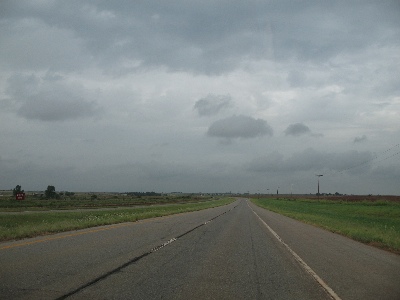
Amazing UFO/ET Eyewitness July 29, 1952 Enid, Oklahoma. Sidney Eubank went to the Enid police station and told Sergeant Vern Bennell that an enormous disk had buzzed his car as he drove between Bison and Waukomis on Highway 81. The rush of air made the car leave the road while the object flew west very fast.
The Enid land office, to prove a claim, required evidence indicating that basic improvements of a permanent nature had been made, such as digging a well, or erecting a house. Many settlers satisfied this requirement by digging a dugout or erecting a sod house. One group of imaginative settlers proved their individual claims by transporting a shanty 14x16 from Kansas onto a claim, proving up, and repeating this procedure three times with the same shanty.
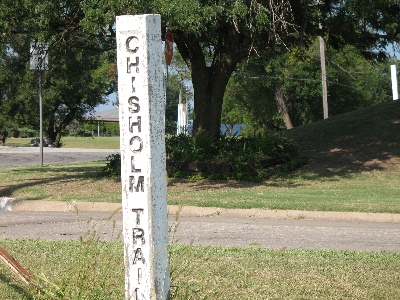
It took seven years, but Bob Klemme of Enid (pop. 47,045) marked the Chisholm Trail across Oklahoma with 400 concrete signposts. The 800-mile trail from the Rio Grande near Brownsville, Texas, to Abilene, Kan., was used for the great cattle drives from the 1860s to 1880s.
Freak accidents resulting in fright, blindness or death
At Enid, Oklahoma T. John Ralston was sitting on a porch in front of the Glass Mountain House, smoking and enjoying the coolness of the evening. Suddenly a bat darted into his face, either designedly or by accident, and both eyeballs were punctured. Efforts at restoring his sight failed and he was blind for the rest of his life.
Sherman Billingsley, who founded the famed Stork Club, grew up in Enid, Okla. In its heyday, the Stork Club was not an ordinary urban watering hole. Under Billingsley's command, the Stork Club became famous all over America. It was a key New York social institution, its owner one of the most powerful arbiters of the era's overlapping contests for status.
Book excerpt:
"One night in 1940, back in New York, Hemingway had grandiosely tried to pay his bar bill at the Stork with a $100,000 royalty check he had gotten for the screen rights to For Whom the Bell Tolls. (A hundred thousand dollars in 1940 would be $1.2 million today.) Billingsley shook his head; no way he could cash that check, not then. But if Hemingway could wait until closing time . . . Then, amazingly, Billingsley did cash it, although it is hard to imagine how, with the club then grossing -- officially, anyway -- by Billingsley's account, $3,500 a night. Now Billingsley needed a favor back. Could Hemingway recommend a good lawyer in Key West? There was this Stork Club there . . ." -- from the first chapter of 'Stork Club'
August 12 1860- Austin, Texas-
Temple Lea Houston (1860-1905), the son of Texas President and governor Sam Houston, was born. He was the first child born in the Governor's Mansion at Austin. In 1873, at the age of thirteen, he joined a cattle drive to Great Bend, Kansas. Later he worked his way east and was employed as a night clerk on a riverboat. Later he enrolled at Baylor University, where he studied law and philosophy and graduated with honors in 1880. Houston became the youngest practicing lawyer in Texas. Houston won a great reputation as a trial lawyer and as a speaker. He carried a pearl-handled pistol, wore shoulder-length hair, a white sombrero, and rattlesnake ties. Houston moved on to Oklahoma after the territory opened up to settlers.
Picture from Wikipedia. Once, while he was in Enid on business, an unknown assailant fired on him, but a copy of the Oklahoma Territorial Statutes that he was carrying stopped the bullet. Houston incorporated the firing of a six-shooter loaded with blanks into his courtroom theatrics on one occasion. After the jury scattered Houston declared them no longer sequestered. On August 15, 1905, Houston died from a brain hemorrhage at his home in Woodward. Among the several fictional characters inspired by Houston's life was that of Yancey Cravat in Edna Ferber's novel Cimarron.
Remember the locomotive that used to sit on the corner across the street east from Pak-a-Sak on East Maine? It is the Frisco 1519, a 4-8-2 Mountain-type locomotive. #1519 was moved to the Oklahoma Railroad Museum (Railroad Museum of Oklahoma) north of downtown several years ago using panel track in the streets to slowly move the locomotive from its former display location.
“Type 4-8-2 built by Baldwin Locomotive Works in 1925. Features 28"x28" cylinders and 69" drivers. Produces 210 pounds steam pressure and 56,800 pounds tractive effort. Engine weight is 342,200 pounds. This engine and tender were presented to the City of Enid placed in a park near St. Mary's Hospital on 11-9-54. It was moved to the Railroad Museum of Oklahoma during November and December of 1997.”
http://www.railroadmuseumofoklahoma.org/page6.html
“In 1926, the SLSF (Frisco) Railway purchased 30 of the 4-8-2 configuration type locomotives from Baldwin Locomotive Works of Philadelphia, Penn. The 4-8-2 designation was devised by Frederick Methvan Whyte and became a way to classify steam locomotives by wheel arrangement. Whyte’s system counted the number of leading wheels, then the number of driving wheels, and finally the number of training wheels, with groups of numbers being separated by dashes. Frisco 1529 had the distinction of being the very last 4-8-2 “Mountain” type locomotive built by Baldwin for the Frisco Railway in 1926. The price tag was a mere $69,586.79 each.
The St. Louis–San Francisco Railway bought a total of thirty 4-8-2s from the Baldwin Locomotive Works to be used in passenger service. Fifteen (road numbers 1500 through 1514) were delivered in 1923, five (road numbers 1515 through 1519) came in 1925 and the final ten (road numbers 1520 through 1529) arrived in 1926. All thirty of these “Mountains” had 28 x 28 cylinders, 69″ drivers, a 210 psi boiler pressure, and 56,800 lbs in total locomotive weight.”
http://www.cityofamoryms.com/our-community/our-history/train/ - City of Amory, Mississippi website. (thanks to Mike Marshall for some corrections and additions)
Published in The Oklahoman, October 13, 1901 Frank Kirk of Enid is the owner of Silver Leaf, a black stallion, that paced an eighth of a mile at Wichita in 13 ¾ seconds. This is said to be a world's record.
A Team of Firsts: On March 31, Enid, Okla., became the first community to join the America Supports You team! More than 1,300 residents rallied at Mark Price Arena in celebration. As part of this initiative, the city will adopt two military units which they will support in the coming months. The units are the 71st Security Forces Squadron from Vance Air Force Base and the 1st Battalion 24th Infantry Regiment from Ft. Lewis, Wash., currently deployed in Mosul, Iraq. The goal is to recruit 20,000 Enid residents to join the effort and support the troops. In addition, the town will participate in a flag swapping ceremony with the two units. The flags will be exchanged in Enid on July 4th

Have you ever wondered about the replica of the Statue of Liberty that is on the East side of the Court House? There are over 200 of these replicas in 39 states in the U.S. and several of its possessions and territories. Enid's is on the Garfield County Courthouse lawn, Grand & Broadway Streets The copper statues were manufactured by Friedley-Voshardt Co. (Chicago, IL) and purchased through the Kansas City Boy Scout office by those wanting one. All were erected in the early 1950's by Boy Scout troops and others to celebrate Scouting’s 40th anniversary theme, "Strengthen the Arm of Liberty.
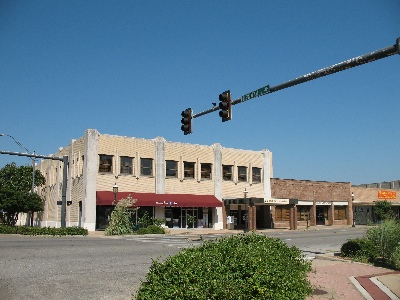
Here's Broadway and Independence. Enid's first bowling alley was upstairs over the stores at the NW corner of Independence and Broadway. It was above the old Sanford Frazier Drugstore. They had to have boys set the pins as there were no automatic pin setters at the time. The setters would get seven cents a string. Read Jack Tenney's story as one of the last great pin setters.
A devastating fire on July 12, 1901, led city officials to create the first Enid Fire Department. On that day, a fire wiped out the entire south side of the city. It started in the back of a secondhand store in the 200 block of South Grand. By morning, the entire block of businesses was engulfed in flames. The fire burned east destroying everything until it crossed a creek and burned out. Flying embers blew west across the street, resulting in the entire south side of the Square going up in flames. Enid's only fire protection consisted of volunteers of the moment, a two-wheeled cart with 500 feet of the fire hose and the horse-drawn Pabst Blue Ribbon hook and ladder. Three days after the fire, the city council conducted a special session to discuss the formation of a volunteer fire department. The council approved formation of Enid Fire Department on March 20, 1902 When it was created, the department consisted of two paid firefighters, each at a salary of $45 a month. The city also authorized 12 volunteers, who were paid $2 for the first hour and $1 for each additional hour of active firefighting. By 1905, the department was located in a wooden building on the southwest corner of Broadway and Grand, about where the post office flag pole now (2002) stands.
$100,000 Fire in Oklahoma
Firemen Forced to Use Dynamite to Check Flames in Enid
Enid, Oklahoma, Jul 14, 1901 - Four blocks of business houses on the public square were destroyed in less than three hours by a fire that started after midnight this morning. Owing to the continued drought, everything burned like matchwood. At light wind blowing from the southeast saved the eastern part of the town. the total loss is estimated at more than $100,000. The insurance will be light. The firemen finally were compelled to blow up several buildings with dynamite and in this manner succeeded in checking the flames. The Post Office and the land office were saved only after a hard fight. The heaviest losers are: Gensman Brothers, $25,000; Crandall & Grugg, $30,000. In most cases the losses were almost total. Enid is a town of about 6,000 inhabitants, situated on the Chicago, Rock Island and Pacific Railroad, and is the county seat of Garfield County. It was established at the opening of Oklahoma over ten years ago, and is one of the most prosperous towns in the territory. The New York Times, Published July 15, 19
According to the Medal of Honor Historical Society, Oklahoma now has five Civil War recipients buried in the state. Another recipient was from the Indian Wars time period. Robert M. Blair Sr., Seaman, USS Pontoosuc. He was awarded the Medal of Honor on June 22, 1865 for his actions on board the USS Pontoosuc during the capture of Fort Fisher and Wilmington from December 24, 1864 to January 22, 1865. He is buried in Lot 17 of Block E in the Enid Cemetery, Enid, Oklahoma.
His grave was marked with a regular government headstone without any mention of the Medal of Honor. Charles Chambers of Houston, Texas and a member of the Medal of Honor Historical Society made arrangements to replace his old and weathered headstone with the distinctive gold leaf lettering of a new Medal of Honor marker. Blair was born at Peacham, Vermont in 1836. (His newspaper obituary indicated he was born in 1840 in Scotland and came to America as a tailor.) He married Anna J. Pitcher of Stafford County, Kansas on August 16, 1885. They had two children Ruby M. Blair, born November 27, 1888 and Robert M. Blair, Jr., born on August 10, 1891. Robert M. Blair, Sr. died on April 2, 1899 and Anna J. Blair died about July 4, 1904.
We don't know when it was dammed up, but there was a man made lake of about 40 acres which extended from South Johnson and Garriott West to Cleveland. George Mosher, a dairy farmer, dammed Boggy Creek from where it crosses South Johnson today. In those days Boggy Creek had lots more water than it does today. The lake that backed up behind the dam was a popular boating and picnicking spot for Enid residents. The dam was in the low-lying area just a couple of blocks south of Garriott on Johnson. George dynamited the dam in 1912 after one of his sons drowned in the lake. Below is the full story:
November 20, 2010
Remembering Enid's once and former lake
By Cindy Allen, Managing Editor Enid News and Eagle
ENID — In the past several years, Enid city commissioners and others have tossed around the idea of building a lake in Enid.
T.J Mosher, 93, said many people don’t realize Enid actually had a fairly large lake in the early 1900s.
Mosher’s grandfather, George Mosher, owned a dairy farm and a tract of land south and west of what now is the intersection of Buchanan and Garriott in southwest Enid. On that tract, about 40 acres of the quarter section were taken up by a lake that extended from Johnson and Garriott west to Cleveland.
But the lake came to an end, along with several surrounding properties, when George, in a fit of grief over the drowning of his young son in a pond near the lake, used dynamite to blow up the dam and destroy the lake.
T.J. said his grandfather hadn’t counted on the water from the lake gushing along Boggy Creek across town and into the Southern Heights addition, flooding some of it.
Mosher Lake was well known to Enid residents as a recreational area. Old photographs printed in previous editions of the Enid newspaper show people canoeing and swimming in the lake. To make the lake, George Mosher had dammed Boggy Creek about where it crosses South Johnson today. In those days the creek carried more water.
The dam was in a low-lying area just a couple of blocks south of Garriott on Johnson.
George Mosher was a prominent Enid resident. The family had come to Enid when the Cherokee Strip was opened. He owned a Guernsey dairy farm and the family lived in a two-story house at the corner of Washington and Randolph.
The lake had been considered too deep for Mosher’s youngest sons, William, 9, and Hugh, 7, according to news reports in late July 1911. The boys usually waded in nearby creeks. But on that hot summer day in 1911, Hugh and Willie, as he was called, sneaked away for a swim, and they ended up swimming in a stock pond very near the actual lake, according to news reports.
At suppertime, Willie returned home and was very quiet. His family inquired about where young Hugh was, and Willie said he didn’t know, but that Hugh had gotten mad at him earlier and had gone to a friend’s house.
Newspaper reports of the day say Enid residents got involved in the search for the boy. One of Mosher’s older sons found a bathing suit in a field that Willie had been wearing earlier in the day. He apparently had gotten rid of it after the drowning. The older brother suspected Willie wasn’t telling the truth, and he pressed the boy. Finally, Willie confessed the two boys had been playing in the water and Hugh had gotten into trouble. Willie had tried to save his brother with a long pole, but he couldn’t.
Mosher’s older son dove into the water and found Hugh’s body in about four feet of water, according to the 1911 news report.
T.J. has been re-telling this story for several years. The Enid News & Eagle has published stories about the lake and the flood, although it is unclear whether the flood occurred right after the boy’s drowning in 1911 or perhaps in the summer of 1912.
As the story goes, George Mosher was in such grief he decided to destroy Mosher Lake. He took sticks of dynamite and blew the dam. After the flood there were lawsuits, T.J. said; however, no lives were lost.
However, T.J., who was born in 1918 — seven years after the drowning — said he remembers the dairy business continued.
T.J. said he remembers when he was a high school student in 1934, some remains from old boats and cement still could be seen in the area where the lake had been.
T.J. says he chuckles when he hears people talking about building a new lake.
“People say it would be grand if we just had a lake,” he said. “Well, we had one. ”
T.J. said he is the last of the Moshers re-telling the story to the Lions clubs and other organizations.
“When I’m gone, it will be the end of that history,” he said.
Check out Legends and Folklore for more interesting stories
October, 2008, Enid's tradition of preserving the past has resulted in a new honor for the city. Enid has been named a Preserve America community, making it one of the top communities in historic preservation in the country.
Secret Service Took Psychic's Advice on Bush Assassination Plot
By Jeff Stein | July 31, 2009 2:20 PM
The Secret Service changed a motorcade route for the first President George Bush based on a psychic's vision that he would be assassinated, according to a new book about the presidential protective agency.
"In the President's Secret Service: Behind the Scenes with Agents in the Line of Fire and the Presidents They Protect," by veteran author Ronald Kessler, evidently is stocked with such juicy items, considering the steady drip of leaks about the book over the past few weeks.
It's a curious development, considering that the White House protective detail is supposed to see everything but say nothing about its main client, the President of the United States.
But Kessler, a former investigative reporter at The Washington Post and Wall Street Journal and author of several "inside" books on U.S. intelligence, has obviously drilled a hole in the Secret Service's wall of silence, which began crumbling in earnest a few years back with former agents telling tales about President John K. Kennedy's mistresses.
Today Kessler passed along the following anecdote about the psychic, the Secret Service and the 1992 reelection campaign of Bush, taken from his new book, scheduled for publication Aug. 4.
(A Secret Service spokesman at first told SpyTalk it was "false," which he later amended to, "It doesn't make sense.")
In Kessler's telling, Bush was scheduled to give a speech on September 17, 1992, at the civic auditorium in Enid, Oklahoma.
"Agent Norm Jarvis was assigned to run intelligence investigations for the visit, and a detective from the Oklahoma State Bureau of Investigation called him," Kessler said by e-mail.
"He said that a woman who was a psychic had told her police contact, whom she worked with on a homicide case in Texas, that she had had a vision that President Bush was going to be assassinated by a sniper."
The police contact, a detective, "told Jarvis that this psychic's visions had actually helped police find buried bodies and had provided useful leads in criminal investigations," Kessler said. "Another seasoned law enforcement homicide investigator from Texas also told Jarvis that he needed to pay attention to her."
Kessler continued:
"Jarvis interviewed the woman, who provided more details from her vision. Jarvis asked her to pinpoint where the president's limo was. She said it was at the Air Force base near Enid. He asked if she could take him to it; she agreed.
"As they drove toward the five hangars on the base, the woman gave Jarvis directions."
Kessler quotes Jarvis as saying:
"As we got close to this one hangar, she said to slow down."
The woman said, "Something is in that building right there."
"What do you mean?" Jarvis asked.
"Something important is in that building there."
"Okay, but not the limo?"
"No," the woman said.
Kessler says, "As they drove past another hangar, the woman said it contained the limo. She then identified another hangar as containing something important.
"Jarvis's hunch was that the limo was in the firehouse bordering the runways. As it turned out, he was wrong and the psychic was right.
"Secret Service agents guard the president's limo until he steps into it. Jarvis checked with them and learned that the hangar identified by the psychic as housing the limo did indeed contain two presidential limousines.
"As more details from the psychic turned out to be right, the advance leader decided the psychic could not be ignored. Never mind if anyone thought they were crazy. Better safe than sorry, he and Jarvis thought."
The leader of the Secret Service advance team ordered the motorcade to take an alternate route, avoiding the overpass, Kessler says. Bush was unharmed.
Secret Service spokesman Edwin Donovan said Kessler's story, "doesn't make sense. We don't make practice of changing a motorcade route based on a psychic."
But Donovan, who spent five years on the presidential protective detail, conceded that Agent Jarvis could have told the story to Kessler.
"You'll have to ask the agent," he said.
Kessler said he would not make Jarvis, who is retired, available for an interview.
"The Secret Service cooperated on the book, the first time it has cooperated on a book about the agency," he said in an e-mail.
One result is Kessler's report that the agency's "management has been cutting corners since the agency's absorption by the Department of Homeland Security, risking the assassination of President Obama, Vice President Biden, and future presidential candidates."
In an interview with Kessler for the book, Secret Service Director Mark Sullivan "denied that the agency has been cutting corners," Kessler said.
Did you know that when the The Barrow's gang hid out in two tourist cabins in Great Bend, Kansas, they committed numerous robberies in Oklahoma to support Bonnie's medical needs and other financial needs of the gang?
On June 26, 1933, Clyde Barrow was in Enid and stole the car of Dr. Julian Fields while it was parked outside of the hospital. He was after a medical bag that was left in the car.
On July 7, 1933, while in Great Bend, Clyde and part of his gang traveled back to Enid, Oklahoma and robbed the National Guard Armory of weapons and ammunition. The Armory was then located on the campus of Philips University. Their stash of weapons was so large they didn't know what to do with them all.
Soon after that, they drove to the home of Pretty Boy Floyd in Salisaw, Oklahoma to see if a safehouse could be found for Bonnie's healing. However, they never made contact with Pretty Boy Floyd, and decided to keep Bonnie in Great Bend, Kansas.
See more: Clue left behind
Historians have estimated that at least 18 percent of the Indians that survived the Trail of Tears were Black. "History speaks of the ‘Trail of Tears’ in the past tense, and perhaps for the Indian nations it is, but for Black Indians 173 years later, they find themselves still traveling this journey," Eleanor "Gypsy" Wyatt, chairman of the Freedman Descendents of the Five Civilized Tribes told those gathered at the first annual Enid, Oklahoma, Black Indian pow wow. She was speaking of the forced march at gunpoint that thousands of Native Americans endured in the 1930s after the United States government decided that they wanted the Indian lands east of the Mississippi. In 1830, Congress passed the Indian Removal Act. The bill called for the removal of all Indians in the southeastern United States to the territory west of the Mississippi River. In 1838, the first groups started out on their 1,000-mile trek, which became known as the Trail of Tears because of the horrors faced, such as disease, lack of food, water and bad weather.
Oral Roberts, evangelist, pastor, healer, innovator and religious icon began his career in Enid. In 1947 Roberts, who believed he had been healed of youthful tuberculosis directly by God via a faith healer, was a minister with his own little Pentecostal Holiness church in Enid, Oklahoma (700 block West Pine). He felt frustrated and trapped as a dirt-poor, small-town preacher with a pleasant but complacent congregation. One harried morning he picked up his copy of the Good Book, and his eyes fell on III John 1:2: "I wish above all things that thou mayest prosper and be in health, even as thy soul prospereth." It changed in an instant his whole understanding of God. God is good, Roberts now saw: God wants us to be healthy; God wants us to succeed; God wants us to be rich! Roberts achieved great success as a revivalist and faith healer--which is to say, he became a central figure in a marginal movement. But his ministry transcended Pentecostalism's lowly origins. Not content with success as a traveling tent preacher, he built a far-flung empire of evangelical outreach, complete with television and radio programs, magazines, newspaper columns, even comic books.
The movie Twister references the city just before the chasers leave Aunt Meg's House to chase the "Hailstorm Hill" Tornado. The storm warning being broadcast over the television says that the latest warning has been issued "for Garfield County, including the city of Enid."
from: Stephen King's book: 11/22/63
“When I finished enjoying this wonderful test, I filled out the answers (with the occasional cry of “You’ve got to be shitting me!”) and sent it back to Enid, Oklahoma. I got a postcard by return mail congratulating me on passing my exam. After I had paid an additional fifty-dollar “administration fee,” I was informed, I would be sent my degree. So I was told, and lo, so it came to pass. The degree was a good deal better looking than the test had been, and came with an impressive gold seal. When I presented it to a representative of the Sarasota County Schoolboard, that worthy accepted it without question and put me on the substitute list.”
Hank Williams, Jr. talks about how he met a woman in Enid, in a song called "Greeted in Enid" from the 1995 album Hog Wild.
In the novel Left Behind (book one of the original 12-book set), primary character Chloe Steele Williams returns home from California by a flight that lands in Enid to make connections, Enid being the only operable airport in the area during the 48 hours after the "vanishings."
In the CBS series The Big Bang Theory (Season 3, Episode 13), character Sheldon Cooper contemplates moving to Enid because of its "low crime rate" and "high speed internet" service, but decides against it because the city lacks a model railroad store.
The First National Bank of Enid was another venture by oilman H.H. Champlin. During the Great Depression it earned the distinction of being the only bank ever to be forcibly closed by the military.
Enid is also mentioned in passing in a few popular novels and films. In Chapter 12 of The Grapes of Wrath, Enid is one of the towns that feeds into Route 66 from the north via Route 64. In the 1995 novel Left Behind, primary character Chloe Steele Williams returns home from California by a flight that lands in Enid to make connections. The Enid Woodring Regional Airport was the only operable airport in the area during the 48 hours after the "vanishings."
The Enid airport was named Woodring Airport in 1933. It was named after I.A. Woodring, an Enid man who was one of the “Three Musketeers of Aviation,” with the Army Air Corps. Lt. Irvin A. Woodring was born Feb. 1, 1902, in Enid and became one of the top stunt and test pilots in the United States, along with John J. Williams and William Lewers Cornelius. The group performed aerobatics at the National Air Races.
Williams died in practice at Los Angeles in 1928. Charles Lindbergh joined the group after Williams’ death. Two weeks later, Cornelius died when his plane collided with another plane. Woodring died in an airplane accident on Jan. 20, 1930, falling 2,000 feet to his death at Wright Field in Dayton, Ohio, after his plane exploded in midair, according to records from the Federal Aviation Administration.
NEW HAVEN, Ct. (BASN) -- The sports headline on the March 27, 1930 edition of the Kansas City American read "MONARCHS FIRST TEAM TO PLAY BALL BY FLOODLIGHT".
Just over a month later on April 29, the defending world champions of the Negro Leagues would go where no professional baseball had ever gone before.
That night, the Kansas City Monarchs defeated Phillips University 12-4 in an exhibition game played in the town of Enid, Oklahoma. But the game's outcome pales in comparison to its place in baseball history.
It is believed to have been the first professional baseball game played under lights.
(http://blackathlete.net/artman2/publish/BASN_Focus_On_History_4/Let_There_Be_Light_printer.shtml)
THE DALTON GANG
In the spring of 1889, the gang turned up again in the Indian Territory, and when Oklahoma was opened to settlement the Dalton boys secured a choice claim for their mother near Hennessey, where she still lives, supported by one of her sons. At the time of the opening Bob Dalton was a United States deputy marshal, being selected on account of his peculiar fitness to deal with desperate characters. After the opening he returned to his life of outlawry and he and Grant [Grat] were then joined by their brother Emmett, the youngest of the brothers. They were at that time also joined by Texas Jack and soon gathered about them several desperate characters.
It was then that the most successful period of the Daltons' career, from their standpoint, began. Their attention was first directed to the robbing of express trains, and they perpetrated many successful "hold-ups," the most noted of which are the robberies of the Santa Fe at Wharton, at Red Rock, of the Missouri Pacific at Adair, and of the 'Frisco near Vinita. The Wharton robbery was perhaps the most dramatic of all. The robbers went to Wharton on horseback, and entering the station there, asked the operator if the train was on time. He replied he would inquire, and was about to do so when one of the band, fearing the operator had recognized them, shot him dead upon the spot without a word of warning. When the train arrived it was held up after the regulation manner. In the pursuit of the robbers which followed, outlaw Ed [Charles] Bryant was captured at Enid by Deputy United States Marshal Ed Short, known throughout the entire territory as a most brave officer. Short placed the captive in the baggage car of the Santa Fe train to take him to Guthrie. He had disarmed him, placing a brace of revolvers on a convenient trunk, and placed the desperado in irons. When the train reached Adair, Short disembarked to send a telegraphic message. When he re-entered the car Bryant had secured one of his weapons and holding it in his manacled hands fired and fatally wounded Short. The officer, however, had strength to raise a Winchester and put four bullets into Bryant's body, expiring as he pulled the trigger the last time.
SourceURL:file://localhost/Users/curtis/Desktop/Ann's%20Stuff/New%20Buzz%20Pages/Trivia%20and%20Facts.doc
The Tour of 1898
When the Circus came to town (when Oklahoma was still a Territory)
Containing an Account of Events of More or Less Importance
From: Red Wagon Annual. A Route Book of Ringling Brothers World’s Greatest Shows, Season 1898
The season of 1898 marks the fifteenth annual milestone in the history of the World’s Greatest Shows.
Enid, OK Ter. Friday, Oct. 7. Good run. Arrive early. Nice lot one block from the principal square. Rainy and gloomy in the morning, but cleared up at noon. Business was packed, extra and all. Ralph Breed visits friends here. The candy stands did a land office business all day and the "butchers" smiled. "That dance" was the side show winner here.
The Dacomas, costumed as they appear in the acrobatic act
Did you know that a stolen 1969 Joe Namath Super Bowl ring turned up in 1978 in an Enid Pawn Shop? Pawn shop owner Delbert Cearley contacted Namath to give it back. Now you know!
Amelia Earhart
In June, 1931 Amelia Earhart went on a Beech-Nut Transcontinental Autogiro Tour which stopped in many cities across the US including Oklahoma City. After leaving a show in OKC, Earhart reportedly flew to Enid, OK! For more information see:
https://enidbuzz.com/amelia-earhart/
From Enid she was to fly to Wichita Falls, TX and then on to Abilene.
